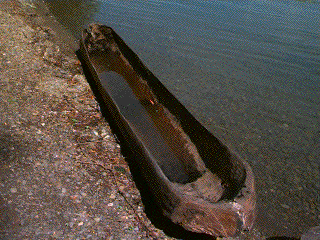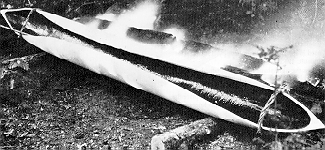| Dugouts
The
two photographs show boats made from hollowed out logs. The top boat is
a dugout in which the material in the center of the log has been hewed
out. The width of the final structure is determined by the log diameter.
The bow of the dugout has been shaped to reduce drag from the water flowing
past the boat.
In
the lower picture an extension of this technique is shown. The aspen log
is hollowed out, but over the central region this process took place through
the rather narrow slit shown. Once this is done the wood is heated to increase
its flexibility and the sides of the center section are stretched by inserting
transverse poles. Once the desired shape has been obtained this is stabilized
by inserting permanent beams to replace the temporary poles. In some cases,
ribs may be fitted below the cross beams (thwarts) and additional planking
can be used to increase the freeboard of the boat. The expansion of the
sides tends to cause the bow and stern to curve upwards.
|

